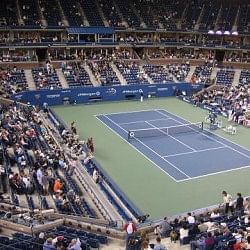
Tennis: Are hardcourts hurting the game or benefiting it?
The ballerina on court, Gael Monfils, dances his way through his matches on nearly all the surfaces used on the ATP World Tour. The feat of sliding on hardcourts is something unique to Monfils. There are others, such as the King of Clay, Rafael Nadal, who do not feel that at home on hardcourts. Despite the fact that the majority of ATP tournaments are played on hardcourts, many players are not pleased with the extra tax placed on their bodies by hardcourts. Why are hardcourts preferred by the tournament organizers nowadays?
Tennis is one GIANT business

Hardcourts, such as the one used in the US Open, are much cheaper and easier to maintain
There are several reasons as to why hardcourts are favoured. For one, the courts require little maintenance – it doesn’t take rocket science to figure that out. Wimbledon is a tournament known for its well-maintained grasscourts. But what is not so well-known is that months prior to the tournament, officials examine the quality of the grass, replant the diseased patches, fertilize the land, mow the lawns… the list goes on. Clay courts are not that much better off. People need to periodically water the red clay to keep it from cracking. However, clay courts are also hard to dry – under the rainy London weather, Wimbledon on clay would last about twice as long because the officials would often need to delay matches for the clay to dry.
Hardcourts, on the other hand, are synthetic. They require very low maintenance in nearly all types of climates (with the exception of extremely hot environments where they are prone to cracks). The maintenance fees are half the cost of grass and clay courts. In the world of business, the lower the (maintenance) cost, the more money the tournament organizers get to pocket.
Think of the players as actors
World-class athletes such as Federer and Djokovic, who we are so accustomed to watching, are perfectionists. Besides winning matches, their other priority is to perform their best on court – such as striking clean balls and moving well throughout the game. Hence, hardcourts, which allow players to more accurately predict the ball’s bounces, hold an advantage.
Let’s think like physicists. Clay courts are made out of dirt. It’s impossible to ensure that a ball does not hit a hard spot, causing the ball to speed up, or to ascertain that a ball does not hit a clump of dirt, resulting in an unstable bounce. It is also hard to control balls’ bounces on grass. For instance, a loose piece of clay and a newly planted piece of grass produce very different bounces. Hardcourts, however, are flat all around. This attribute allows the players to have an easier time on court and focus on producing overpowering winners and spectacular shots.
The clashes of the styles
Although no one knows for certain if the general trend towards a hardcourt-filled tour is good for tennis, few players have been very vocal about the problems and implications of the general trend.

Rafael Nadal is very outspoken about his dislike for hardcourts
Rafael Nadal, the former world No. 1 who recently captured the Indian Wells title, does not like the idea of more hardcourt tournaments. He firmly advocates for a diversified and balanced tennis tour that features tournaments played on surfaces other than hardcourts. He does have good reasons: hardcourts are not easy on the players’ bodies – a lot of players and scientists agree that hardcourts may shorten a player’s career. Nadal, who plays a very physical game, has frequently commented that hardcourts are straining his body a lot. If football players don’t play on cement, why should tennis players?
The harm in a uniform culture
Despite the advantages of employing hardcourts, the global tennis tour should certainly remain diversified and balanced. After all, tennis is a diverse game full of rich traditions. The history books have on record the serve-and-volley exponent Rod Laver and the all-court player Roger Federer in addition to defensive and offensive baseline bashers like Andy Murray and Novak Djokovic. A hardcourt dominated tour would encourage players to adopt a baseline game in order to win more matches. It is, therefore, in the best interests of the game to encourage a variety of styles on tour. Clashes of styles only make tennis more interesting. In the past, rivalries such as those between polar opposites of Federer and Nadal and Sampras and Agassi kept the game interesting.
Tennis is evolving at a faster pace than ever before because of the internet and global communication. The dilemma of the hardcourts is certainly hard to resolve; we must keep an open and active mind when trying to create a world where tennis flourishes.